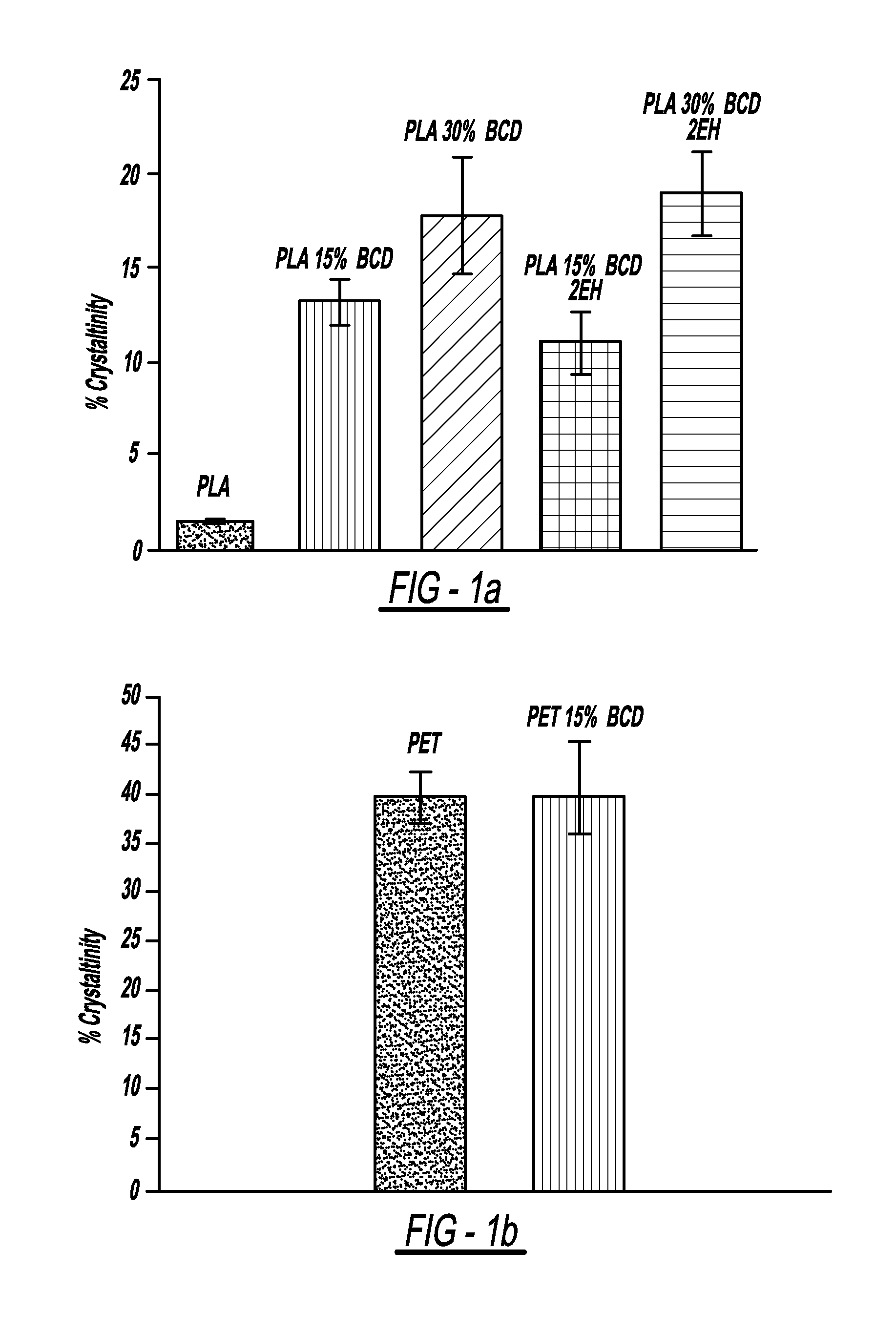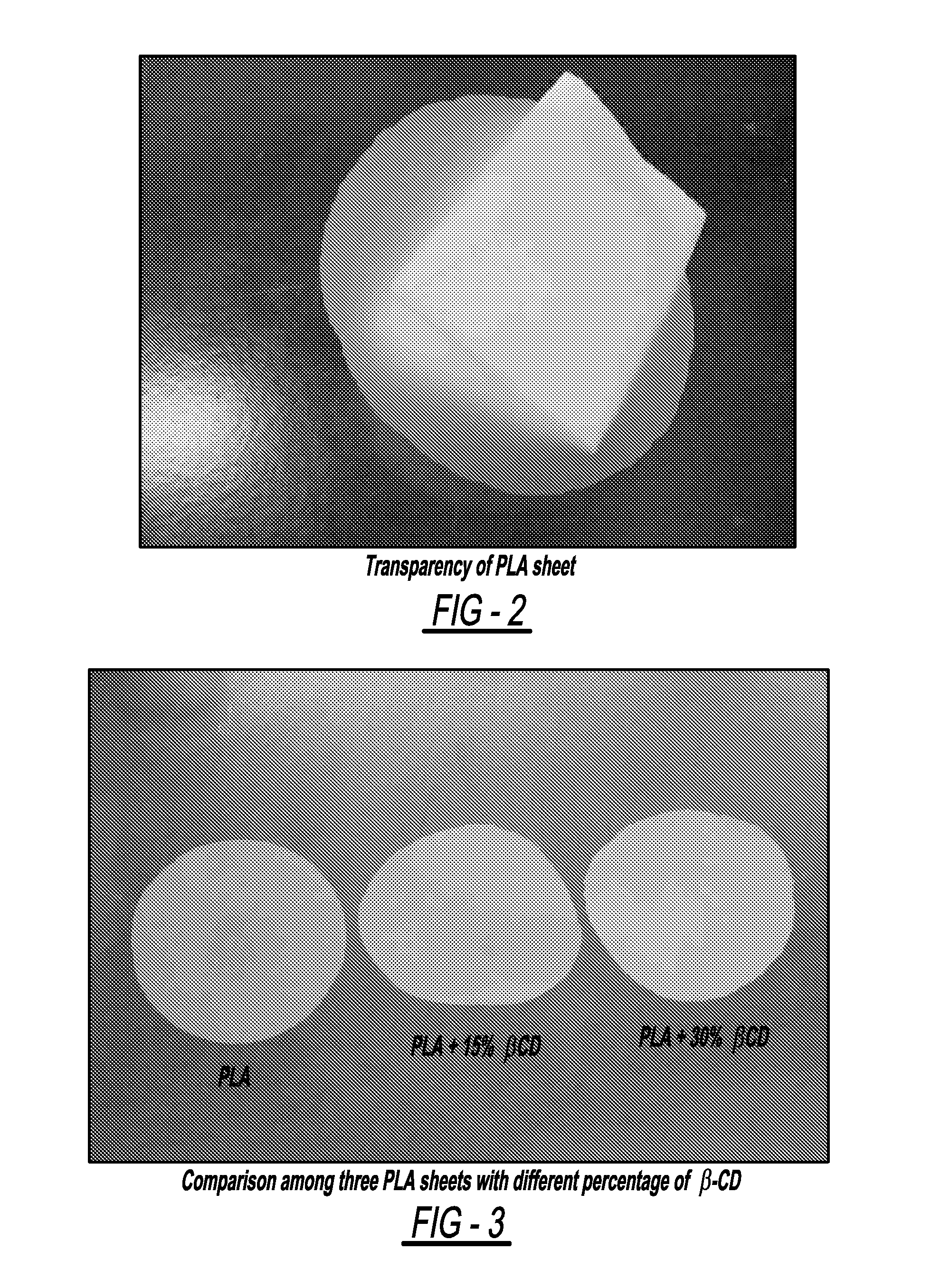Beta-cyclodextrins as nucleating agents for poly(lactic acid)
a technology of beta cyclodextrin and poly(lactic acid), which is applied in the field of systems for preventing post-harvest fungal diseases of produce, can solve the problems of premature release from the application point, difficult control of fresh produce organisms, and short lifespan of perishable items, and achieve the effect of increasing the crystallinity of pla
- Summary
- Abstract
- Description
- Claims
- Application Information
AI Technical Summary
Benefits of technology
Problems solved by technology
Method used
Image
Examples
example i
[0030]A cyclodextrin / water solution (1:1 molar) was prepared by adding β-cyclodextrins to a beaker containing hot distilled water (100° C.) and stirring at 225 rpm using a hot plate stirrer (Thermolyne® Mirak™ hot plate / stirrer; Sigma-Aldrich Corp., Saint Louis, Mo.). An amount of 315 μl of 2E-hexenal was slowly released into the solution and then stirred for two hours. After that, the beaker was transferred to a new stirrer plate (Thermolyne Nuova II Stir Plate, Bamstead International, Testware, Sparks, Nev.) for thirty minutes at room temperature. Finally, the sample was centrifuged at 1600 rpm for one hour and the precipitate obtained was dried at 60° C. overnight. All samples were kept in hermetically sealed flasks at 23° C.
[0031]An example of the measurement of the emission of hexanal from the inclusion complexes of the present invention is presented herewith in Example II, below:
example ii
[0032]A simple desorption system was used to evaluate the efficacy of the ICs (e.g., see Almenar, E.; Auras, R.; Rubino, M.; and Harte, B., “A new technique to prevent main postharvest diseases in berries during storage: inclusion complexes β-CD-hexanal, Int. J. Food Microbiol., (2007)). Glass vials ( 40 mL) were filled with 1 ml of distilled water and on the bottom of these a 2-mL glass vial containing 0.1 g of inclusion complex was positioned. Vials were immediately closed with Mininert® valves (Supelco, Bellefonte, Pa.). After 24 hours, hexanal concentrations released from the IC to the vial headspaces were measured using a 65-μm DVB / CAR / PDMS SPME fiber (Supelco, Bellefonte, Pa.) and a Hewlett-Packard 6890 Gas Chromatograph (Agilent Technology, Palo Alto, Calif.) equipped with FID and a HP-5 column (30 m×0.32 mm×0.25 μm). The fiber was exposed to the vial headspace for 10 minutes. The volatiles trapped in the SPME were quantified by desorbing the volatile (for 5 minutes) at the s...
example iii
[0034]PLA was dried overnight at 60° C. The polymeric material and β-CD or ICs were weighed as per the calculated compositions (e.g., see Table I below) and mixed together and fed to the extruder barrel of a micro twin screw extruder equipped with an injection molder system (TS / I-02, DSM, The Netherlands). The temperature of the three zones of the extruder was 186° C. PLA was melted at 180° C. and then all the compounds were mixed at 100 rpm for 2 minutes. The mini-extruder was equipped with co-rotating screws having lengths of 150 mm, with L / D radio of 18 and net capacity 15 cm3. After extrusion, the materials were transferred through a preheated cylinder (180° C.) to the mini injection molder (40° C.) to prepare bar- and disk-shaped specimens for various analyses. The attached injection molding unit was capable of 120 psi injection force.
TABLE ISample codes of PLA and its blendsSample CodePolymer (%)β-CDs (%)Antifungal volatilePLA1000NonePLA 15% BCD8515NonePLA 30% BCD7030NonePLA 1...
PUM
| Property | Measurement | Unit |
|---|---|---|
| Fraction | aaaaa | aaaaa |
| Fraction | aaaaa | aaaaa |
| Fraction | aaaaa | aaaaa |
Abstract
Description
Claims
Application Information
 Login to View More
Login to View More - R&D
- Intellectual Property
- Life Sciences
- Materials
- Tech Scout
- Unparalleled Data Quality
- Higher Quality Content
- 60% Fewer Hallucinations
Browse by: Latest US Patents, China's latest patents, Technical Efficacy Thesaurus, Application Domain, Technology Topic, Popular Technical Reports.
© 2025 PatSnap. All rights reserved.Legal|Privacy policy|Modern Slavery Act Transparency Statement|Sitemap|About US| Contact US: help@patsnap.com



